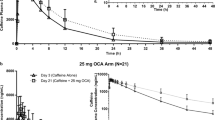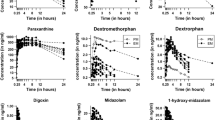Abstract
Objective
To evaluate felodipine as a potential perpetrator of pharmacokinetic drug-drug interactions (PK-DDIs) involving cytochrome P450 (CYP) enzymes and P-glycoprotein (P-gp).
Methods
Felodipine extended-release 10 mg was administered daily to six healthy subjects for 7 days (days 1–7). Subjects were administered a modified Inje cocktail comprising the selective probe substrates caffeine 100 mg (CYP1A2), losartan 25 mg (CYP2C9), omeprazole 20 mg (CYP2C19), dextromethorphan 30 mg (CYP2D6), midazolam 2 mg (CYP3A) and digoxin 250 μg (P-gp) on day 0 (prior to felodipine exposure) and day 7 (after felodipine exposure). Plasma samples were collected over 24 h and drug concentrations measured by UPLC-MS/MS.
Results
The geometric means of the area under the plasma concentration–time curve ratios (probe AUC after felodipine exposure/probe AUC prior to felodipine exposure) and 95 % confidence intervals for each probe were: caffeine 0.91 (0.64–1.30), losartan 1.05 (0.95–1.15), omeprazole 1.17 (0.78–1.76), dextromethorphan 1.46 (1.00–2.12), midazolam 1.23 (0.99–1.52) and digoxin 1.01 (0.89–1.15).
Conclusion
Felodipine may be a weak in vivo inhibitor of CYP3A and CYP2D6 but is unlikely to act as a significant perpetrator of PK-DDIs.


Similar content being viewed by others
References
National Heart Foundation (2010) Guide to managment of hypertension 2008. Assessing and managing raised blood pressure in adults. Updated 2010. National Heart Foundation, Sydney
Bailey DG et al (1991) Interaction of citrus juices with felodipine and nifedipine. Lancet 337(8736):268–269
Jalava KM, Olkkola KT, Neuvonen PJ (1997) Itraconazole greatly increases plasma concentrations and effects of felodipine. Clin Pharmacol Ther 61(4):410–415
Capewell S et al (1988) Reduced felodipine bioavailability in patients taking anticonvulsants. Lancet 2(8609):480–482
Ma B, Prueksaritanont T, Lin JH (2000) Drug interactions with calcium channel blockers: possible involvement of metabolite-intermediate complexation with CYP3A. Drug Metab Dispos 28(2):125–130
Polasek TM et al (2004) Mechanism-based inactivation of human cytochrome P4502C8 by drugs in vitro. J Pharmacol Exp Ther 311(3):996–1007
Walsky RL, Gaman EA, Obach RS (2005) Examination of 209 drugs for inhibition of cytochrome P450 2C8. J Clin Pharmacol 45:68–78
Smith SR et al (1987) Pharmacokinetic interactions between felodipine and metoprolol. Eur J Clin Pharmacol 31(5):575–578
Meyer BH et al (1992) The effects of felodipine on the pharmacokinetics of diazepam. Int J Clin Pharmacol Ther Toxicol 30(4):117–121
Rehnqvist N et al (1987) Pharmacokinetics of felodipine and effect on digoxin plasma levels in patients with heart failure. Drugs 34(Suppl 3):33–42
Butani L, Berg G, Makker SP (2002) Effect of felodipine on tacrolimus pharmacokinetics in a renal transplant recipient. Transplantation 73(1):159–160
Polasek TM, Miners JO (2007) In vitro approaches to investigate mechanism-based inactivation of CYP enzymes. Expert Opin Drug Metab Toxicol 3(3):321–329
US Food and Drug Administration, Guidance for industry. Drug interaction studies—study design, data analysis, and implications for dosing, and labeling recommendation. 2012: Rockville, MD
European Medicines Agency, Guideline on the investigation of drug interactions. 2012: London, UK
Lahiri DK et al (1992) A non-organic and non-enzymatic extraction method gives higher yields of genomic DNA from whole-blood samples than do nine other methods tested. J Biochem Biophys Methods 25(4):192–203
Wright GEB et al (2010) Elucidation of CYP2D6 genetic diversity in a unique African population: implications for the future application of pharmacogenetics in the Xhosa population. Ann Hum Genet 74(4):340–350
Hsiao CL, Wu YC, Hsu KY (2011) Pharmacokinetics of felodipine extended-release tablets in healthy Taiwanese subjects: a retrospective review. Arzneimittelforschung 61(8):444–451
Olkkola KT, Backman JT, Neuvonen PJ (1994) Midazolam should be avoided in patients receiving the systemic antimycotics ketoconazole or itraconazole. Clin Pharmacol Ther 55(5):481–485
Kang BC et al (2002) Influence of fluconazole on the pharmacokientics of omeprazole in healthy volunteers. Biopharm Drug Dispos 23:77–81
Harder S et al (1988) 4-quinolones inhibit biotransformation of caffeine. Eur J Clin Pharmacol 35(6):651–656
Williamson KM et al (1998) Effects of erythromycin or rifampin on losartan pharmacokinetics in healthy volunteers. Clin Pharmacol Ther 63(3):316–323
Greiner B et al (1999) The role of intestinal P-glycoprotein in the interaction of digoxin and rifampin. J Clin Investig 104(2):147–153
Ryu JY et al (2007) Development of the “Inje cocktail” for high-throughput evaluation of five human cytochrome P450 isoforms in vivo. Clin Pharmacol Ther 82(5):531–540
Kirby B et al (2006) Simultaneous measurement of in vivo p-glycoprotein and cytochrome P450 3A activities. J Clin Pharmacol 46(11):1313–1319
Fuhr U, Jetter A, Kirchheiner J (2007) Appropriate phenotyping procedures for drug metabolizing enzymes and transporters in humans and their simultaneous use in the “cocktail” approach. Clin Pharmacol Ther 81(2):270–283
Andersson T (1996) Pharmacokinetics, metabolism and interactions of acid pump inhibitors. Focus on omeprazole, lansoprazole and pantoprazole. Clin Pharmacokinet 31(1):9–28
Sica DA, Gehr TW, Ghosh S (2005) Clinical pharmacokinetics of losartan. Clin Pharmacokinet 44(8):797–814
De Smet M et al (1995) Effect of multiple doses of losartan on the pharmacokinetics of single doses of digoxin in healthy volunteers. Br J Clin Pharmacol 40(6):571–575
Oosterhuis B et al (1991) Minor effect of multiple dose omeprazole on the pharmacokinetics of digoxin after a single oral dose. Br J Clin Pharmacol 32(5):569–572
Polasek T et al (2011) Perpetrators of pharmacokinetic drug-drug interactions from altered cytochrome P450 activity: a criteria-based assessment. Br J Clin Pharmacol 71(5):727–736
Bengtsson-Hasselgren B et al (1990) Acute effects of felodipine and nifedipine on hepatic and forearm blood flow in healthy men. Eur J Clin Pharmacol 38(6):529–533
Rowland M, Tozer TN (1995) Clinical pharmacokinetics: concepts and applications. 3rd ed. Williams & Wilkins, Baltimore
Acknowledgments
We thank Prof. Martin Kennedy and Ms. Allison Miller at the Carney Centre for Pharmacogenomics (University of Otago, Christchurch, New Zealand) for CYP2D6 genotyping. We also thank Dr. Helen Healy for clinical support during the study visits and Dr. Ganessan Kichenadasse for useful feedback on the study design.
Conflict of interest
None declared.
Author information
Authors and Affiliations
Corresponding author
Electronic supplementary material
Below is the link to the electronic supplementary material.
Supplementary Table 1
(DOCX 26 kb)
Supplementary Table 2
(DOCX 26 kb)
ESM 1
(DOCX 31 kb)
Rights and permissions
About this article
Cite this article
Snyder, B.D., Rowland, A., Polasek, T.M. et al. Evaluation of felodipine as a potential perpetrator of pharmacokinetic drug-drug interactions. Eur J Clin Pharmacol 70, 1115–1122 (2014). https://doi.org/10.1007/s00228-014-1716-8
Received:
Accepted:
Published:
Issue Date:
DOI: https://doi.org/10.1007/s00228-014-1716-8




